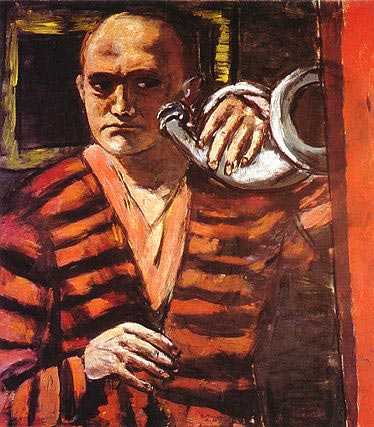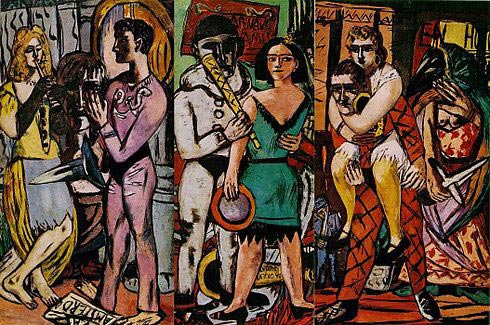| Max Beckmann | |
|---|---|
 |
|
| Born | Feb. 12, 1884 |
| Died | Dec. 28, 1950 (at age 66) |
| Nationality | German |
| Field | Painting, Sculpture, Drawing, Printmaking |
| Works | View Complete Works |
Max Beckmann was born in Leipzig Germany in 1884. He was the son of a grain merchant. His father died when Max was about 10 years old. By the age of 15 he already knew he would become a painter. He was certain that was his destiny. After completing his academic education he would soon marry a young woman he met at school. Minna Tube also was an artist. They were to have one child whom they named Peter.
After he finished school in 1903, graduating from the Weimer Academy of arts, Max Beckmann made many trips to Paris where he was enthralled with the artistic accomplishments on display. Within three years Max had himself become a renowned artist. His paintings at the time were inspired by the impressionists of the era and were quite popular. He was making a substantial living by the age of 30. Eventually he became disillusioned with his work and destroyed many of his earlier paintings.
Technique and Style
Max Beckman began as a traditional painter who was well taught in the technical aspects of art as is revealed in his earlier paintings. However his style and technique began to change when he became a corpsman volunteer in the military during the Great War (WWI). His style gradually transitioned into Expressionism as he subtly depicted the pain and violent tone of war. One painting in particular reveals this: The Small Operation, 1915. It is powerful in its expression of the pain of war. It was in 1915 that seeing the horrors of war finally caused Beckmann to suffer a nervous breakdown. He was discharged from service in 1917. His art began to reveal powerful emotions brought on by the experience of the war.
 When World War 2 broke out, Max Beckmann’s as well as other Expressionists’ paintings were declared to be degenerate by Hitler. In Fact his paintings were removed from the galleries by the Nazis and some were displayed as examples of degenerate art in Munich. The Nazi Government referred to Beckmann as a “cultural Bolshevik.”
When World War 2 broke out, Max Beckmann’s as well as other Expressionists’ paintings were declared to be degenerate by Hitler. In Fact his paintings were removed from the galleries by the Nazis and some were displayed as examples of degenerate art in Munich. The Nazi Government referred to Beckmann as a “cultural Bolshevik.”
In 1937, while in self-imposed exile to Amsterdam, Beckmann’s work became more intense and powerful. The bold lines and the distortions of space and figures were indicative of his view of the world and of himself.
Eventually moving to the United States after the war ended, Max Beckmann’s work became very popular. His style has been said to resemble medieval stained glass. Beckmann’s art is a mirror that reflects the very radical changes in both art and the world in the 20th century.
Themes
Beckmann’s artwork very often reflects the brutality of the Nazi’s and the great agony of Europe brought on by two world wars. However there are many subjects that depict enormous faith and beautiful redemption as well. He also painted a substantial amount of self-portraits. These were generally very intense paintings that revealed much of the way he saw himself. They were an attempt to define him as he struggled with the conflicts of the world as he perceived it.
Legacy
Much of Max Beckmann’s later works are displayed in the United States. His earlier work was almost exclusively viewed in Europe up until about 1984 when a small exhibit was held at Nassau County’s Suburban Art Museum. Since that time, Beckmann’s work has achieved international recognition and is displayed in art museums throughout the world including the renowned Guggenheim museum in New York and the Centre Pomidou in Paris France.
Art
One of Beckmann’s well known triptychs, Oil On Canvas is rather autobiographical depicting his childhood in the right side panel and a fantasy dream in the left side panel. The center panel depicts an intermingling of his school days and dream fantasy.
Painted in 1943, Max Beckmann’s Les Artistes Mit Gemuse ( Artist with Vegetable) has been on display at the Mildred Lane Kemper Art Museum in St. Louis, Missouri.
Selling Of The Prisoners which Beckmann painted in 1905 is now owned by the Robert Gore Rifkind Center Foe German Expressionist Studies.
The Los Angeles County Museum Of Art is home to Max Beckmann’ s oil Painting titled Bachanal. It was painted in 1909. Currently it is not on view.
Max Beckmann is considered one of the most prominent artists of the 20th Century. Some of his paintings sell at well over 1 million dollars and are coveted by art dealers and collectors worldwide.